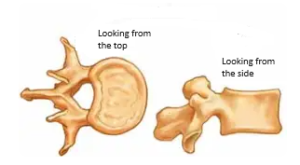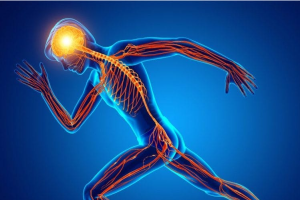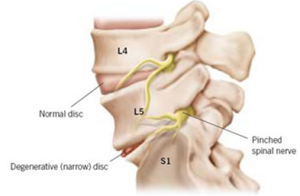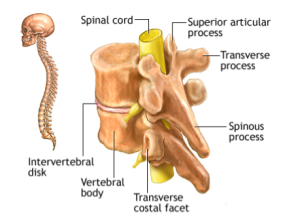Lesson 3: A closer look at Vertebrae and Nerves
In this lesson, I am going to try to explain how the spine bones all fit together, and talk about nerves, so you can more easily understand some of the more common back issues I’ll talk about further down the track.
Spine Bones (Vertebra)
As we learned previously, the spine is made up of a bunch of square looking bones that stack on top of each other to make the spine. In the picture below, the chunky square part faces toward your front, and the poky bit is at your back and you can touch this.
In the picture, you can also see that between the square chunky bit and the poky bit, there is a hole. When the bones all stack up on one another, a tunnel is created running all the way down the spine. This is called the spinal canal, and in it, lives the spinal cord. We all know the spinal cord is very important, which is why it is very well protected in this tunnel of bone.
Spinal Cord and Spinal Nerves
The spinal cord is like a big thick rope that comes out of your brain. All the way down along the spinal cord, there are smaller pieces of rope attached called “spinal nerves”. This is how the messages travel from the brain to the rest of the body. Like a train in the tunnel.

So, a message to move your arm will leave the brain and travel down the spinal cord inside the bony tunnel. At some point in the neck region, the message will leave the spinal cord and continue on the smaller spinal nerve which runs down the arm, and delivers the message. 
As well as the messages for movement, messages of sensation like pain and pressure also run in the spinal nerves then up the spinal cord and back to the brain.

If you need to move your leg, your brain will send a message down the spinal cord. It will run all the way down the spinal cord in the tunnel to the level of your lower back, where the message will move from the spinal cord to the spinal nerve, and travel down the spinal nerve toward the leg, and the leg will eventually move.

A great system, til it isn’t.
It’s a very clever system, and for the most part works very well. But you can imagine, there are lots of things that can go wrong.
As a physio we commonly see the system get compromised mecahnically at 2 different places.
Spinal stenosis
If the tunnel gets narrowed, the spinal cord gets squashed and sends pain into your arms, legs or body. When the canal gets narrowed, this is called spinal stenosis. I will explain spinal stenosis more in depth another time.

Neural Foramen
Just as the spinal cord travels down a tunnel of bone, when the spinal nerve leaves the spinal cord and heads out to the rest of the body, it also passes through a smaller tunnel. This smaller tunnel is made by very convenient matching dents on each side of the vertebra, which make a nice little hole or tunnel for the spinal nerve to pass through.

This neural foramen (hole for the nerve) is fraught with problems. Anything that narrows this hole by even a mm irritates the spinal nerve, and that sends pain into your body. Ie if the spinal nerve gets squashed or irritated at the level when it leaves your neck, your arm will hurt. Even if there’s nothing wrong with your arm!! (how rude!) And if it gets squashed in your lower back, your leg will hurt. And what’s more, it they get squashed even more, the messages of movement won’t be able to get through either.

In the clinic
The irritation of spinal nerves, and the subsequent pain that they cause, is probably the single most common thing we see in the clinic. And to the non professional, the signs and symptoms of these two causes are very similar. Back and leg pain are the most commonly self diagnosed and treated conditions with the help of Dr. Google.
However, although the symptoms are very similar, the treatment for these two are polar opposites. So rather than diagnose and treat yourself, make yourself an appointment and let’s work out what is going on with your body, and which course of action is best for you!
By Lesley Tompson.
1 Comment
Chiropractor in North Lakes · November 24, 2023 at 6:44 pm
This insightful exploration into the intricate relationship between vertebrae and nerves offers a valuable lesson, seamlessly blending clarity with complexity to empower readers on their journey to understanding the pivotal role of spinal health in overall well-being.